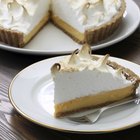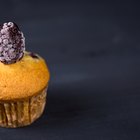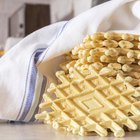
Making cream puffs teaches you just how much fun an egg contains. Simple ingredients and simple culinary techniques let you create a pastry that is simultaneously crisp and tender, ready to serve as a tasty hors d'oeuvre or fanciful dessert. The challenge of cream puff pastry, pate a choux, is precision. The steps are easy but must be followed exactly to avoid cream-puff collapse. With care, your efforts will yield puffs of delight.
Temperatures
Cream puff pastry is an emulsion, in which essentially incompatible ingredients -- butter, eggs and flour -- must be as thoroughly combined as possible. Cream puffs deflate when the ingredients are not combined at the right temperatures. At the beginning, make sure that simmering milk, water, butter and salt are kept hot over medium heat while you beat in the flour. You will know the mixture is hot enough if you see a thin film of cooked dough on the pan. This means flour and butter can combine thoroughly. Whether you keep the cooked dough in the pan and beat by hand or transfer the dough to the bowl of a stand mixer, make sure the dough is warm to the touch before you add eggs. Very hot dough will cook bits of egg prematurely, while cold dough will not absorb the eggs thoroughly. Keeping the first mixture hot and the second warm maximizes the ability of ingredients to combine, making the resulting puffs puffy.
Beating and Textures
Several stages of choux pastry-making require prolonged beating. This effort elongates gluten fibers in flour, incorporates butter and ensures the eggs combine thoroughly with other ingredients. While recipes may specify three to five minutes of beating of flour and liquids, the cooked film on the bottom of the pan and a smooth, elastic, only slightly glossy dough are the best signs that your mixture is well beaten. High gloss means the butter is not fully incorporated and the puffs will be greasy and flat. Adding eggs to warm dough changes the texture, and, as you begin to incorporate each egg, the whole mixture will look lumpy, clotted and wet. Beat until the dough returns to a smooth state, then add the next egg. Failure to incorporate all the eggs thoroughly makes the puffs streaky, uneven and often flat.
Baking
The two most frequent causes of flat cream puffs during or after baking are uneven oven temperatures and inadequate baking time. Recipes typically start baking at 425 degrees Fahrenheit, then lower heat to 350 F after 10 minutes. The initial heat forces rapid steam expansion needed for puffing, and subsequent moderate heat crisps the outer crust and dries the puff inside. An oven thermometer can ensure your oven temperatures are correct and may help you avoid hot or cold spots in your oven. Set a timer so you know when to reduce the temperature. Subsequent baking usually takes about 20 minutes, but can be slightly confusing. The outer crust should be medium-brown and dry-looking. Test for inner moisture by inserting a thin wooden or metal skewer in the top. When the skewer comes out dry, the puffs are done. If you have not made cream puffs before, making a couple of extra test puffs can prevent you from removing the whole batch too early.
Cooling
Nothing is more discouraging than watching a tray of puffs flatten as they cool. The cause is almost always excess internal moisture. Set the puffs on a rack to cool and poke a small hole in the top of each one with a skewer to release excess steam that could cause them to collapse. A solid outer crust will keep these small vent-holes from deflating the puffs like pricked balloons. Cool them completely before frosting or filling.
Related Articles

Why Use Baking Powder in Pancake Batter?

How to Stop a Meringue From Being Sticky
A Substitute for Meringue

What Causes Cupcakes to Fall?

What Causes Cupcakes to Be Dry?

What Causes Cheesecakes to Sink in the ...

What Happens When You Forget to Put ...

How to Stiffen Meringue
Why Are My Biscuits Always Flat?

How to Make Vanilla Ice Cream With ...
Why Do My Biscuits Turn Out Hard and ...

How to Make Pizzelle Crisp in High ...
What Causes My Cake to Fall When ...
What Causes a Cheesecake to Split When ...

How to Make Breadmaker Bread Less Dense

How to Make Elastic Pizza Dough So You ...
Secret to Making Soft Chewy Italian ...

Can You Make Croissants With Baking ...

What Is the Difference Between Puff ...

How to Make Bread Chewy
References
Writer Bio
Janet Beal has written for various websites, covering a variety of topics, including gardening, home, child development and cultural issues. Her work has appeared on early childhood education and consumer education websites. She has a Bachelor of Arts in English from Harvard University and a Master of Science in early childhood education from the College of New Rochelle.
Photo Credits
Ryan McVay/Photodisc/Getty Images